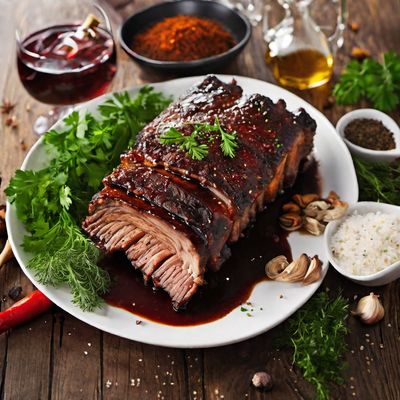
Ingredient
Balsamic vinegar and similar
The Tangy Elixir: Unveiling the World of Balsamic Vinegar
Balsamic vinegar is a dark, syrupy condiment made from cooked grape must, which is the juice extracted from freshly crushed grapes. It undergoes a slow fermentation and aging process in wooden barrels, resulting in a complex flavor profile with a perfect balance of sweetness and acidity. The vinegar has a deep brown color, a thick consistency, and a distinct aroma that is both sweet and tangy. It adds depth and complexity to dressings, marinades, sauces, and even desserts. Balsamic vinegar is often used as a finishing touch to enhance the flavors of dishes, and its versatility makes it a staple in both traditional and modern cuisine.
Origins and history
Balsamic vinegar originated in Italy, specifically in the region of Modena and Reggio Emilia. Its roots can be traced back to the Middle Ages when it was first produced as a medicinal tonic. Over time, it gained popularity as a culinary ingredient and became a symbol of wealth and prestige. The traditional method of producing balsamic vinegar involves aging it in a series of wooden barrels, with each barrel imparting its unique flavors and characteristics to the vinegar. Today, balsamic vinegar is renowned worldwide and is protected by the European Union's Protected Designation of Origin (PDO) status, ensuring its authenticity and quality.
Nutritional information
Balsamic vinegar is low in calories, with approximately 14 calories per tablespoon. It contains no fat or cholesterol and is a good source of antioxidants, including polyphenols, which have been linked to various health benefits.
Allergens
Balsamic vinegar does not typically contain any known allergens, but individuals with grape allergies should exercise caution.
How to select
When selecting balsamic vinegar, look for bottles labeled "Aceto Balsamico di Modena" or "Traditional Balsamic Vinegar of Modena" to ensure authenticity. Check the ingredient list to ensure it is made from grape must and aged in wooden barrels. Opt for vinegars that have a denser consistency, as they tend to be of higher quality. Additionally, consider the age of the vinegar, as older varieties often have a more complex flavor.
Storage recommendations
To maintain the freshness and quality of balsamic vinegar, store it in a cool, dark place away from direct sunlight and heat sources. Seal the bottle tightly after each use to prevent oxidation. Properly stored, balsamic vinegar can last for several years without losing its flavor.
How to produce
While producing balsamic vinegar requires specialized knowledge and equipment, amateur enthusiasts can try making their own versions using grape juice, vinegar, and a slow aging process in wooden barrels or containers.
Preparation tips
Balsamic vinegar can be used in a variety of ways. It is commonly used as a dressing for salads, drizzled over roasted vegetables, or used as a marinade for meats. It can also be reduced to create a syrupy glaze or used as a finishing touch on dishes like strawberries and ice cream. When using balsamic vinegar, start with a small amount and gradually add more to achieve the desired flavor, as its intensity can vary between brands.
Substitutions
Red wine vinegar or apple cider vinegar can be used as substitutes for balsamic vinegar, although they may not provide the same depth of flavor and sweetness.
Culinary uses
Balsamic vinegar is a versatile ingredient used in a wide range of culinary applications. It is commonly used in salad dressings, marinades, sauces, and reductions. It pairs well with fruits, cheeses, roasted vegetables, and grilled meats. Its sweet and tangy flavor adds a delightful complexity to dishes, making it a favorite among chefs and home cooks alike.
Availability
Balsamic vinegar is widely available in supermarkets, specialty food stores, and online retailers. It is commonly produced in Italy, particularly in the regions of Modena and Reggio Emilia, but variations of balsamic vinegar can also be found in other countries.
More ingredients from this category
Recipes using Balsamic vinegar and similar » Browse all

Hungarian Foie Gras with Sweet Onion Jam
Indulgent Delight: Hungarian Foie Gras with Caramelized Onion Jam

Fugazza with Caramelized Onions and Mozzarella
Savory Delight: Caramelized Onion Fugazza

Insalata di Pere e Pecorino (Pear and Pecorino Salad)
Delightful Harmony: Pear and Pecorino Salad

Crispy Artichoke Caponata
Mediterranean Delight: Crispy Artichoke Caponata

Risotto Amarone
Velvety Amarone Risotto: A Taste of Italian Elegance

Maltese Bruschetta
Mediterranean Delight: Maltese Bruschetta with a Twist

Nouvelle Jibarito
Elevating the Jibarito: A Nouvelle Twist on a Puerto Rican Classic

Teriyaki Chicken with Italian Twist
Italian Teriyaki Chicken: A Fusion of Flavors

Haute Cuisine Barbecue Ribs
Elevated Smoky Ribs with a Gourmet Twist

Italian-style Sushi Rolls
Mamma Mia Sushi Rolls

Roasted Duck Breast with Orange Glaze
Succulent Citrus-Glazed Duck Delight

Fragole al Vino Rosso
Sweet Strawberry Delight: Fragole al Vino Rosso Recipe
